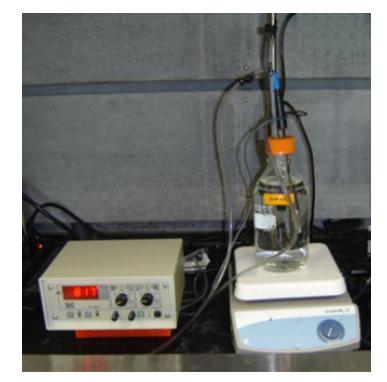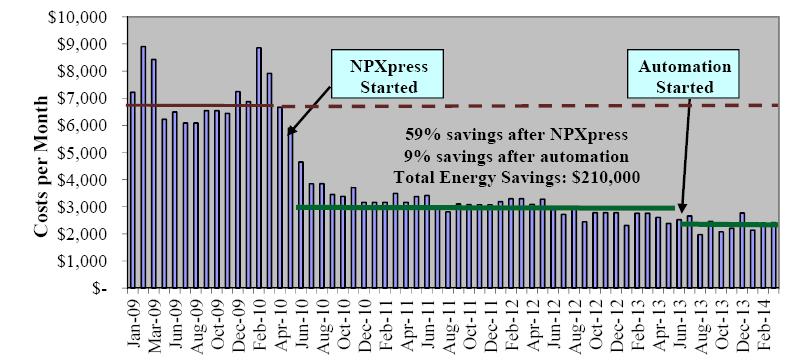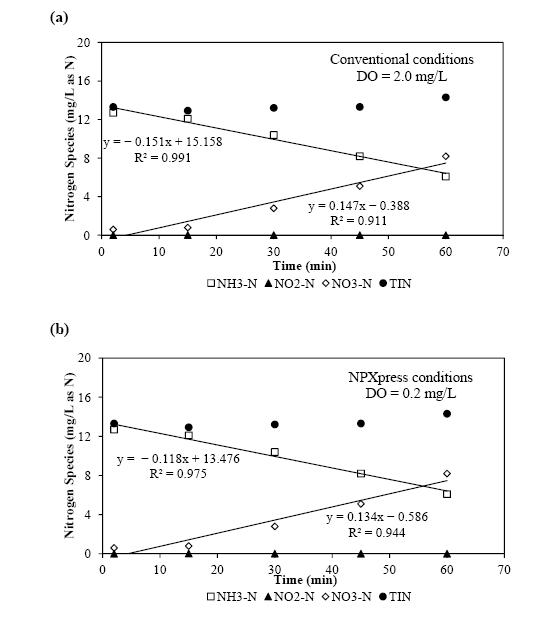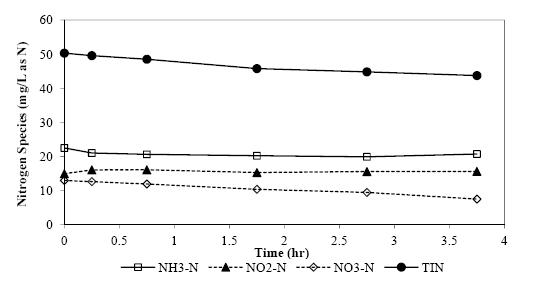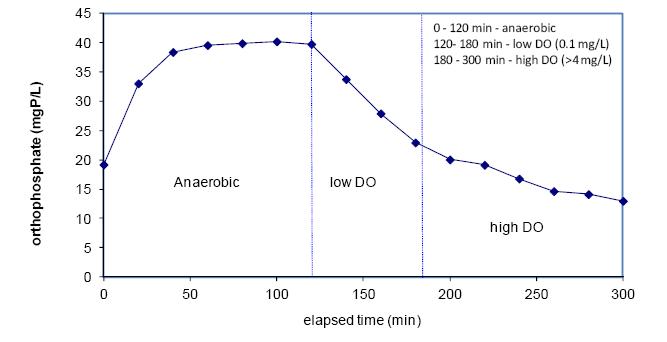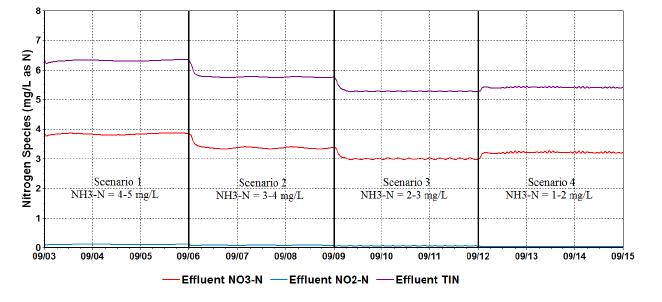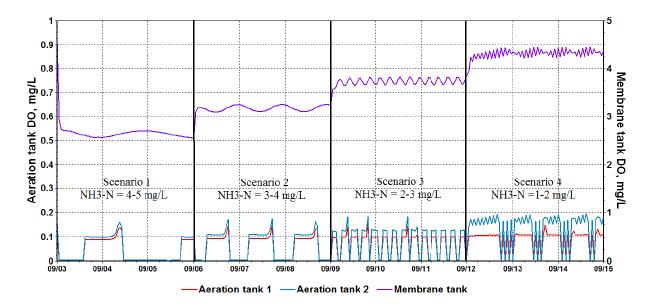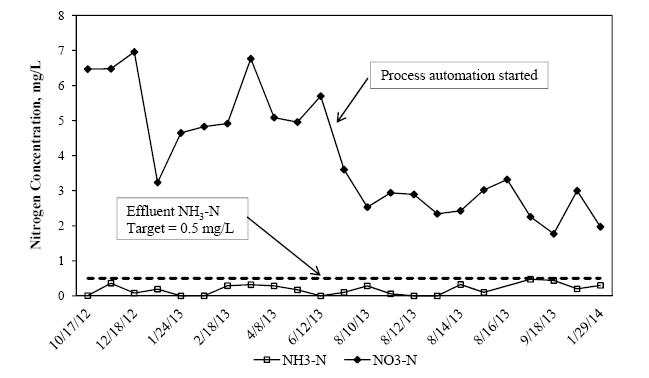1. Introduction
Regulations related to the nitrogen and phosphorus concentrations in the discharged wastewater are becoming more stringent. Membrane bioreactor (MBR) technology is gaining popularity and employed as tertiary treatment to produce high quality effluent that can meet discharge limits and be beneficially reused for various applications [1, 2]. Compared to conventional activated sludge systems, the operating costs of MBR systems are still quite high due to air scouring for membrane cleaning and aeration demand for carbon and nitrogen removal [3]. Conventional nitrogen removal requires substantial oxygen input for nitrification and supplemental carbon source for denitrification. There have been significant interests in the recent past in the development of new nitrogen removal processes that reduce energy and chemical requirements for conventional nitrification-denitrification processes and can be applied to optimize MBR plants. Several recent advanced approaches in nitrogen removal technology include intermittent aeration, simultaneous nitrification and denitrification (SND), and the enrichment of novel microorganisms such as anaerobic ammonium oxidation (anammox) and ammonia oxidizing archaea (AOA) [4, 5]. Studies have shown that aeration energy can be saved by using an intermittent aeration process to create a so-called “swing-zone” while achieving a similar level of nitrification and denitrification efficiency compared to continuous aeration processes [6, 7, 8].
Simultaneous nitrification and denitrification (SND) process is a promising strategy under investigation to reduce aeration energy. It has demonstrated multiple benefits over conventional processes if operated properly, and some of these include: (i) savings in aeration energy by operating the aeration tank with low dissolved oxygen (DO) concentrations; (ii) use of less supplemental carbon source; and (iii) less sludge production. SND was found in full-scale conventional treatment systems and MBR plants [9] and a DO level of 0.5 mg/L is necessary to promote a SND process [10]. American Water’s research team has developed an innovative application of ultra-low DO (less than 0.2 mg/L) operations for wastewater treatment uniquely referred to as NPXpress and successfully implemented it at several full-scale MBR plants. However, the kinetics of nitrification and denitrification in those full scale MBR plants were not thoroughly investigated. It was also found that ultra-low DO operations were challenging to maintain at a stable level due to limitations in process monitoring and control. The majority of the efforts to investigate SND have been conducted at a lab-scale or pilot-scale level [11, 12, 13, 14]. As a result, there is a gap between lab-scale studies and full scale real world operation experience for MBR plants that are operated with low energy intensity, especially for ultra-low DO operations. In addition, kinetics of nutrient removal process under NPXpress conditions need to be further investigated as well.
Process modelling is a great tool to evaluate wastewater treatment processes and helps to develop an aeration control strategy. Wastewater treatment process simulators tie together biological, chemical, and physical process models and can be used to design, upgrade, and optimize wastewater treatment plants of all types. The dissolved oxygen half saturation coefficient (KDO) is a key parameter used in wastewater treatment modelling representing oxygen affinity of nitrifiers. An elevated KDO value indicates lower oxygen affinity. Typically, ammonia oxidizing bacteria (AOB) have a higher oxygen affinity than nitrite oxidizing bacteria (NOB) which leads to a lower KDO value for AOB. In one wastewater process simulator (BioWin, EnvironSim Associates) the default KDO values for AOB and NOB are 0.25 mg/L and 0.5 mg/L, respectively. KDO values vary a lot in different treatment systems [15, 16]. The ultra-low DO operations in MBR systems are not well understood and determinations of KDO values in the system has a significant impact on process operations since it provides optimum DO concentrations that saves energy while not compromising nitrogen removal efficiency.
Compared to the DO aeration control, ammonia-based aeration control not only reduces energy consumption, but also decreases effluent ammonia concentrations, increases denitrification efficiency, and improves biological phosphorus (bio-P) removal [17]. Simulation of ultra-low DO operations at MBR plants is still challenging and study of ammonia-aeration control using process modelling for those MBR plants to optimize treatment process is limited. In this study, an ammonia-based aeration control strategy was developed based on process simulation and the application of the aeration control strategy at the plant resulted in additional energy savings and improvement of treatment performance.
The objectives of this study were to (i) demonstrate energy and chemical efficient NPXpress technology at a full-scale MBR plant; (ii) investigate the kinetics of nitrogen and phosphorus removal in lab-scale reactors, and (iii) develop an ammonia-based aeration control strategy for energy reduction and treatment improvement using process modelling.
2. Materials and Method
2.1. Full-scale application of NPXpress
Jefferson Peaks Water Reuse Facility (WRF) is located in Hopatcong, NJ with a design flow of 473 m3/d. The facility uses MBR technology to treat municipal wastewater and the produced effluent is used to replenish groundwater. The treatment process is shown in Figure 1. The NPXpress process was implemented at the plant in May 2010. Samples were collected periodically from influent, anoxic tank, aeration tank, membrane tank, and effluent for measuring chemical oxygen demand (COD), ammonia nitrogen (NH3-N), nitrite nitrogen (NO2-N), nitrate nitrogen (NO3-N), orthophosphate (PO4-P), and total phosphorus (TP) concentrations using a spectrophotometer (Hach DR5000, CO) and the corresponding Hach method 8000, 10031, 8507, 10020, 8048, and 8190, respectively. A portable meter (Hach HQ40d, CO) was used to measure DO concentrations. Besides this routine monitoring of process parameters, plant energy consumption and costs were monitored in 2011 to 2014. As a comparison, energy consumption without NPXpress in 2010 was also recorded and used as baseline information.
2.2. Kinetic study for biological nutrient removal
2.2.1. Biological nitrification and denitrification tests
Mixed liquor samples from Jefferson Peaks WRF were collected from the aeration tanks and membrane tanks under normal flow and load conditions. Samples were immediately transported on ice to the lab and stored in the refrigerator (4 ℃) before the kinetic and characterization tests. The tests were typically started the same day or within 24 hours. Mixed liquor samples (1L) were placed in 1.2 L cylindrical glass reactors and equilibrated to room temperature (20 ℃) prior to the tests. At the start of each test, 4 mL of 0.25M KH2PO4 buffer solution (pH = 7.2) was added to the reactors to minimize pH changes. The samples were mixed with a magnetic stirrer during the test. Typical experimental set up is shown in Figure 2. For biological nitrification tests, a stock solution (NH3-N or NO2-N) was added to the reactors to have a final substrate concentration of 15 mg/L. Air was pumped into the reactors through an air bubble stone. DO concentrations were well controlled with automatic DO controllers (Cole-Parmer, IL). Aliquots of 20-30 mL were collected every 15 minutes for one hour. For biological denitrification tests, nitrogen gas was initially purged into the reactors to create anaerobic conditions. Stock solutions (NH3-N, NO2-N, and NO3-N) were added to the reactors to final concentrations of 15 mg/L substrates. Aliquots of 20-30 mL were collected at t = 0, 0.25, 0.75, 1.75, 2.75, and 3.75 hr. All samples from biological nitrification and denitrification tests were immediately centrifuged (Sorvall, MA) at 1500 rpm for 10 minutes, filtered using 0.45 µm membrane filters, and measured for NH3-N, NO2-N, and NO3-N using Hach methods.
2.2.2. Determination of DO half saturation coefficient (KDO) for nitrification
Biological nitrification tests were conducted under a series of DO concentrations (DO = 0.1 ± 0.05, 0.2 ± 0.05, 0.5 ± 0.05, 0.75 ± 0.05, 1 ± 0.05, and 2 ± 0.05 mg/L). The ammonia or nitrite concentrations were plotted against time for each test and linear least square regression was used to model ammonia or nitrite removal over time. The nitrification rates under each DO condition were determined by dividing the slope of the regression lines by mixed liquor volatile suspended solids (VSS) concentrations. The Monod equation (Eq. 1) was used to estimate nitrification kinetics and a linear least square method was used to calculate KDO values for nitrification.
Where:
μ = Specific nitrification rate for nitrifiers, mg N/L· d
μmax = Maximum specific nitrification rate for nitrifiers, mg N/L· d
DO = Dissolved oxygen concentration, mg/L
KDO =Dissolved oxygen half saturation coefficient, mg/L
2.2.3. Biological phosphorus release and uptake test
Phosphorus release and uptake was determined with raw wastewater influent and the mixed liquor samples in the membrane tank from the MBR plant. DO, pH, and PO4-P were measured for both influent wastewater and mixed liquor samples before the tests. Influent wastewater (2L) and phosphate-accumulating organisms (PAOs)-containing mixed liquor samples (2L) were combined and mixed in a batch reactor, and then 0.128 g of sodium acetate was added to the reactor. The mixture was stirred continuously as to keep the sludge suspended. The biological phosphorus release and uptake test lasted 5 hours and included three sequential phases: (i) phase I, anaerobic (DO = 0 mg/L, 120 minutes); (ii) phase II, aerobic (DO = 0.1 mg/L, 60 minutes); and (iii) phase III, aerobic (DO = 4.0 mg/L, 120 minutes). Initially, the reactor was purged with nitrogen gas and kept enclosed to maintain anaerobic conditions. DO concentrations were monitored with a portable meter (Hach HQ40d, CO) and controlled by modifying air flow rate to the reactor. Samples from the batch reactor were taken every 20 or 30 minutes during the entire test to measure PO4-P concentrations. Additionally, NH3-N, NO2-N and NO3-N were measured every 60 minutes. Reactor pH was maintained between 7.0 and 8.0 during the test by adjusting with KH2PO4 buffer solution.
2.3. Process modelling and ammonium-based aeration control
The MBR configuration was set up in a series of three completely mixed reactors followed by membrane modules in the last reactor using BioWin 4.0 (EnviroSim Associates, Canada) to simulate the anoxic tank, aeration tank, and membrane tank. The layout of the process model is displayed in Figure 3. Modifications to the standard activated sludge model equations were necessary to account for the reduced stoichiometry of oxygen utilization and simultaneous nitrogen and phosphorus removal [18]. Typical plant operating conditions as well as default kinetic and stoichiometric parameters were initially used for the model. Both steady-state and dynamic simulations were performed to evaluate plant treatment performance. The process model was calibrated based on plant sampling data and key operational parameters such as mixed liquor suspended solids (MLSS), internal mixed liquor recycle rate, and sludge retention time (SRT). The model was further calibrated using KDO values calculated from the laboratory studies. Four ammonia-based aeration control scenarios were evaluated using the calibrated model in terms of aeration and nitrogen removal efficiencies. The simulation results were used to develop aeration control strategy. YSI online sensors (Xylem, NY) were installed at the plant to monitor real time ammonia concentrations. The ammonia set-points were used to control operation of process blowers to achieve plant automation.
3. Results and Discussion
3.1. Treatment performance
Traditionally, it is recommended that the aeration tank has a DO level of 2.0 mg/L for optimum nitrogen removal [17, 19]. Before the NPXpress conversion, the DO level in the aeration tanks of Jefferson Peaks WRF was higher than 2.0 mg/L. The NPXpress process lowered the DO level to less than 0.2 mg/L and the treatment performance was not negatively affected under ultra-low DO operations (Table 1). Specifically, effluent NH3-N concentrations were consistently below 0.5 mg/L and the average concentration was approximately 0.18 mg/L. Similarly, the average effluent NO3-N concentration was 4.27 mg/L and no differences were found before and after the conversion.
Table 1. Treatment Performance since NPXpress conversion1
| 1 Data are averages of 20 field measurements |
| | Influent (mg/L) | Effluent (mg/L) |
| COD | NH3-N | NO3-N | PO4-P | TP | COD | NH3-N | NO3-N | PO4-P | TP |
| Average | 592 | 47.9 | 0.69 | 5.40 | 7.39 | 23 | 0.18 | 4.27 | 4.17 | 4.60 |
| Maximum | 833 | 89.9 | 1.34 | 8.95 | 9.84 | 58 | 0.47 | 6.96 | 6.50 | 6.36 |
| Minimum | 343 | 34.8 | 0.07 | 2.73 | 4.28 | 11 | 0.00 | 2.26 | 2.67 | 2.96 |
The total nitrogen removal efficiency was over 90% after the conversion. The better treatment performance could be due to establishment of nitrifying and denitrifying microorganisms that can function well under ultra-low DO environment. A novel microorganism, AOA which can thrive under low DO operations, was detected in sludge samples and could lead to the NPXpress process for this MBR plant [5]. It should be noted that approximately 0.016 m3/d supplemental carbon (Micro-C) was added to the anoxic tank for denitrification before implementing the NPXpress; while under NPXpress operations supplemental carbon addition for denitrification was completely eliminated. The total phosphorus removal efficiency was approximately 40% and PAO were accounted for biological phosphorus removal. The discussion of PAO is in the section biological phosphorus release and uptake.
Aeration accounts for half of the operational costs for wastewater treatment. The significant advantage of the NPXpress technology is to reduce oxygen demand or energy input. The overall energy consumption of Jefferson Peaks WRF was monitored before and after the NPXpress conversion. Figure 4 demonstrates energy savings after NPXpress implementation. The total electricity costs were reduced by 59% for Jefferson Peaks WRF. The NPXpress greatly reduces aeration requirements and energy costs while achieving same level of treatment performance.
3.2. Biological nitrification and denitrification tests
Nitrification activity tests were conducted under conventional conditions (high DO) and NPXpress conditions (ultra-low DO). Figure 5 (a) displays results for a typical activity test under aerobic conditions with high DO level (DO = 2.0 mg/L). The NH3-N concentrations decreased and correspondingly the NO3-N concentrations increased, suggesting substantial nitrification in the reactor. The ammonia oxidation rate and nitrate production rate were 27.2 mg N/g VSS·d and 26.5 mg N/g VSS·d, respectively. It is noted that NO2-N concentrations remained quite low in the reactor and no accumulation of nitrite was observed, indicating that all of the ammonia was initially oxidized to nitrite and the produced nitrite was then completely oxidized to nitrate. Figure 5 (b) shows nitrification results under NPXpress conditions (DO = 0.2 mg/L). The ammonia oxidation rate was 21.2 mg N/g VSS·d, which was approximately 78% of the ammonia oxidation rate under conventional conditions. The results demonstrated that microorganisms developed under NPXpress conditions had a higher affinity for oxygen. The nitrate production rate was 24.1 mg N/g VSS·d, which was higher than ammonia oxidation rate possibly due to the conversion of organic nitrogen to inorganic nitrogen during cell decay under ultra-low DO conditions. The NO2-N concentrations remained quite low and no accumulation was observed. The aerobic activity tests under conventional and NPXpress conditions demonstrated that autotrophic nitrification was the mechanism of ammonia oxidation to nitrate.
Figure 6 shows bacterial activity test results under anaerobic conditions. It is obvious that both NH3-N and NO2-N concentrations remained constant after initial conversion of ammonia to nitrite. The conversion could be due to oxygen input when injecting substrates into the reactor. The constant concentrations of NH3-N and NO2-N indicated that anammox was not present in the mixed liquors under ultra-low DO operations. Nitrate in the reactor decreased, indicating that under anaerobic conditions, heterotrophic denitrifying bacteria used nitrate as a terminal electron acceptor to remove nitrogen. The decrease of total inorganic nitrogen (TIN) could be attributed to endogenous respiration by heterotrophic denitrifying bacteria in the batch reactor. The results of the anaerobic activity tests suggested that traditional heterotrophic denitrification is the dominant nitrogen removal mechanism at Jefferson Peaks WRF operated under NPXpress conditions, while other novel nitrogen removal pathway (e. g. anammox) was limited.
3.3. DO half saturation coefficient (KDO)
Both quantitative Polymerase Chain Reaction (qPCR) and microarray analysis demonstrated that AOB were minor participants in the nitrification process, and NOB were not detected in microarray experiments (manuscript in preparation). In addition, no anammox activities were observed as discussed before. Therefore, the dominant organisms responsible for NPXpress are still unknown and further investigations are being conducted. In this paper, ammonia oxidizing organisms (AOO) and nitrite oxidizing organisms (NOO) are used for discussions. The ammonia and nitrite oxidation rates under a series of DO conditions were calculated and the results were used to further fit the Monod equation (Eq. 1). The results of KDO for AOO and NOO were 0.1 mg/L and 0.05 mg/L for mixed liquor samples from Jefferson Peaks WRF. Daebel et al. [15] reported KDO ranges of 0.31-0.57 mg/L and 0.14-0.51 mg/L for AOB and NOB respectively. However, the mixed liquor samples used by Daebel et al. [15] were collected from a domestic wastewater treatment plant with DO concentrations in aeration tanks controlled between 2.5-3 mg/L. At Jefferson Peaks WRF, the DO concentrations in aeration tanks were lower than 0.2 mg/L. The results suggested that KDO values were relatively low under NPXpress conditions and the NPXpress promoted microorganisms with higher oxygen affinity for biological nitrogen removal.
3.4. Biological phosphorus release and uptake
The three-phase design of the biological phosphorus release and uptake test was to mimic the actual full scale plant set-up for the anoxic zone, aeration zone (ultra-low DO), and membrane zone (high DO). Phosphorus was released under anaerobic conditions and taken up under aerated conditions (ultra-low DO and high DO; Figure 7). The rate of phosphorus uptake appeared to be faster under ultra-low DO condition than the rate under high DO condition. This indicated that DO was not the limiting factor for phosphate uptake, but the readily biodegradable carbon source might be the limiting factor for phosphate uptake in the laboratory reactor. The lab-scale results confirmed biological phosphorus removal observed at the plant.
3.5. Process model and ammonia-based aeration control
Once the model was calibrated, it was able to reasonably predict the plant performance for COD, NH3-N, NO2-N, NO3-N and PO4-P. BioWin Controller is a module that can augment BioWin with process control simulation. Four scenarios were set up in the BioWin Controller and simulated using the calibrated BioWin model. Figure 8 and Figure 9 show simulation results for each scenario. It is interesting that the lowest ammonia set point did not result in the highest total nitrogen removal rate. The lowest effluent total nitrogen was achieved when the set point for ammonia was between 2-3 mg/L. The reason could be attributed to unique aeration type in the biological tank. Figure 9 presents DO concentrations in aeration and membrane tanks. Higher ammonia set point led to lower DO concentrations in the membrane tank due to oxygen uptake through ammonia oxidation. Intermittent aeration was found in scenario 3 and the effluent total nitrogen concentrations were the lowest among these four scenarios. Other research teams found that intermittent aeration could improve treatment performance for nitrogen removal [6, 7].
Based on simulation results, scenario 3 was selected as a control strategy to achieve plant automation. The ammonia concentrations in the second aeration tank were constantly monitored by online sensors. Higher ammonia concentrations will turn on the process blowers and lower concentrations will turn off the process blowers. In other words, process blowers were controller by ammonia set point similar to scenario 3. With automatic aeration control, additional 9% electricity cost savings were achieved (Figure 4). Total energy savings were over 60% and over $210, 000 in four years, which equals approximately $0.57/m3operational cost savings. In addition to energy reduction, automatic aeration control improved treatment performance as well. Figure 10 shows effluent ammonia and nitrate concentrations before and after automatic aeration control. The effluent ammonia concentrations were consistently below 0.5 mg/L and effluent nitrate concentrations were gradually reduced to 2-3 mg/L. Ammonia-based aeration control reduced effluent total nitrogen by 35%, which increases treatment capacity and helps the plant prepare for more stringent discharge limits in the future.
4. Conclusion
The implementation of the NPXpress technology at Jefferson Peaks WRF reduced energy consumption without compromising treatment performance. After the NPXpress conversion, the MBR plant completely eliminated the addition of supplement carbon for denitrification which reduced chemical costs, further increasing the value of NPXpress.
Lab-scale kinetic studies suggested that NPXpress promoted microorganisms with higher oxygen affinity or lower DO half saturation coefficients. The KDO values for AOO and NOO were 0.1 mg/L and 0.05 mg/L respectively. The ammonia removal rate under NPXpress conditions was 78% of the rate under conventional conditions. Biological phosphorus removal was also observed in both lab-scale and full-scale studies.
Ammonia-based aeration control was developed and evaluated using process modelling. After application of automatic aeration control for NPXpress process, the overall energy savings were over 60% and approximately $0.57/m3 operational cost savings were achieved in four years. In addition to energy reduction, ammonia-based aeration control also improved treatment performance by reducing effluent total nitrogen by 35%.
Acknowledgments
The authors would like to thank Jim Huntington and Roger Parr for their constant support to the optimization of this full-scale MBR plant, and Dr. Patrick Jjemba for his valuable comments on an earlier version of the manuscript.
Conflict of Interest
All authors declare no conflicts of interest in this paper.









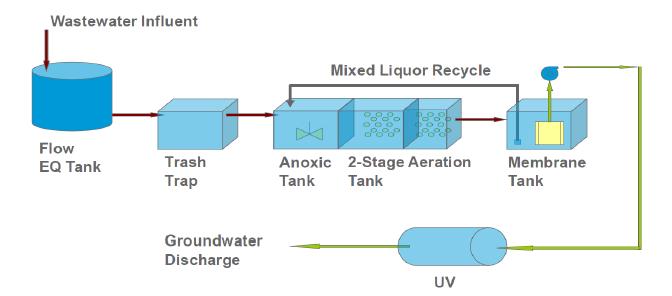
 DownLoad:
DownLoad: 